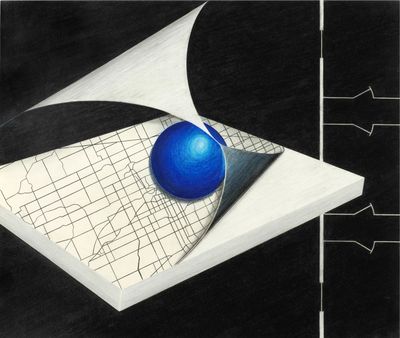Back to Art Essays
Maps
Liberty wraps
The Earth in vanishing maps
. . . Made to disorder
While traveling for business, I felt the urge to try to rediscover an old neighborhood and attempt to find what seemed lost from my kindergarten years. Being a cognitively-impaired human incapable of remembering the ecological footprint of my youth, I headed for the nearest convenience store to purchase a map. As I rotated the carousel, the vibrant whirling display of colors, most notably blues and yellows, came to a stop: I caught a glimpse of run-of-the-mill paper protruding from behind the laminated reproductions shimmering under the fluorescent lights. Like an archaeologist sifting through the sands, I unearthed a two-dollar paper map delineating my former surroundings in simple black-and-red ink. The frugal minimalist in me, seeking lost simplicity, purchased the no-frills map and enjoyed the pleasure of acquiring straightforward information for a couple of dollars.
Soon after hitting the road, I realized that without any address whatsoever, and only the name of the town in which I lived, the map alone could not guide me to my destination. I rested my hopes on intuition reinforced by the recognition of long-forgotten landmarks, which were hard to come by in an area that had been transformed from forests and farmland to a suburban wonderland. Even without any retrieval cues to jog my memory, except the lake I frequently swam in, I still managed to find the street where my family’s former home was located. For some reason, I could not find the house and pulled off in a driveway behind a row of towering pine trees to plot the course back to my hotel.
But behind the pines up on a small hill stood my former abode, much smaller than I remembered, but exuding an inviting welcome-back feel. The pines, now towering over the landscape, had become an atavistic metaphor of a change and a sentimental tribute to times gone by.
With the sentinels behind me, I mustered up the courage to venture to the front door and see who was occupying my former domicile. Oddly enough, the same couple who had purchased my parent’s house approximately three decades earlier had never moved, and after long careers at one of the big-three car manufacturers, mutually agreed to cash in their chips and settle into retirement. On the threshold of the family room, I relived many family traditions ranging from leaving out a shoe with a carrot in it for old St. Nick’s horse to decorating Easter trees out of dead branches—a kind of quirky, yet unintentional, metaphor analogous to resurrection. Even the little things came back to me, like learning to tie my shoes in the hallway and comparing muscle sizes on the back porch in a display of young male bravado. As the images passed by, I promised to send the long-time inhabitants of my former house a few scanned photographs from our family photo albums so they could vicariously share a small pictorial fragment of my experience. After swapping stories and reminiscing, I took one last mental inventory of the surroundings before bidding both the elderly couple and my childhood farewell.
So, equipped with my rekindled memories and an awareness of less is more, I plotted a course back to my hotel where I contemplated the boondoggle into the bucolic pastures of my youth. The two-dollar convenience-store map was significantly different from the one my parents consulted to navigate the unfamiliar Midwestern terrain, which has been perpetually altered by human migration into the area. The imposition of our will on a planet of scarce resources creates a phenomenon where generations of people skin the Earth and re-wrap it with new maps to satisfy their immediate needs. The husband and wife served as a model of patience and stability in a chaotic environment. Yet with all the radical change, the pine trees, a symbol of continuity and growth, remind us that the course to a brighter future depends upon supplying our roots with learning to strengthen the branches of posterity.
Our quality of life will depend on how we choose to cultivate the Earth, and the journey toward a better tomorrow will require a no-frills map in one hand and a child’s hand in the other. Our descendants will inherit more than our biological frameworks: They will become an extension of our experiences, which, in my case, are revived every night before bed when my children ask me, “Daddy, please tell me a story about when you are little.”
Who says you can never go home?
